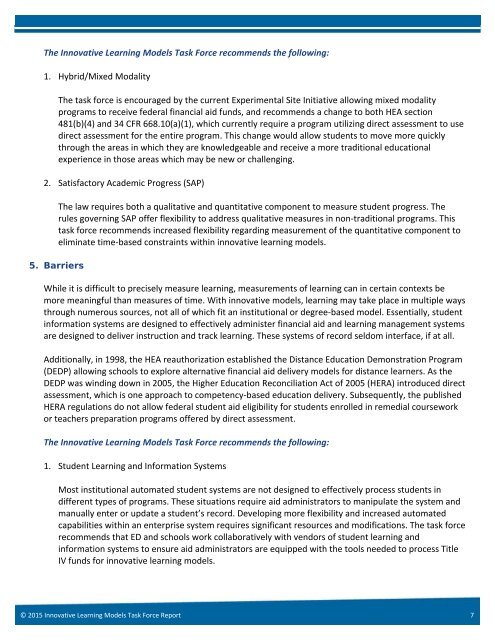INNOVATIVE LEARNING MODELS
Innovative_Learning_ModelsTFReport
Innovative_Learning_ModelsTFReport
Create successful ePaper yourself
Turn your PDF publications into a flip-book with our unique Google optimized e-Paper software.
The Innovative Learning Models Task Force recommends the following:1. Hybrid/Mixed ModalityThe task force is encouraged by the current Experimental Site Initiative allowing mixed modalityprograms to receive federal financial aid funds, and recommends a change to both HEA section481(b)(4) and 34 CFR 668.10(a)(1), which currently require a program utilizing direct assessment to usedirect assessment for the entire program. This change would allow students to move more quicklythrough the areas in which they are knowledgeable and receive a more traditional educationalexperience in those areas which may be new or challenging.2. Satisfactory Academic Progress (SAP)5. BarriersThe law requires both a qualitative and quantitative component to measure student progress. Therules governing SAP offer flexibility to address qualitative measures in non-traditional programs. Thistask force recommends increased flexibility regarding measurement of the quantitative component toeliminate time-based constraints within innovative learning models.While it is difficult to precisely measure learning, measurements of learning can in certain contexts bemore meaningful than measures of time. With innovative models, learning may take place in multiple waysthrough numerous sources, not all of which fit an institutional or degree-based model. Essentially, studentinformation systems are designed to effectively administer financial aid and learning management systemsare designed to deliver instruction and track learning. These systems of record seldom interface, if at all.Additionally, in 1998, the HEA reauthorization established the Distance Education Demonstration Program(DEDP) allowing schools to explore alternative financial aid delivery models for distance learners. As theDEDP was winding down in 2005, the Higher Education Reconciliation Act of 2005 (HERA) introduced directassessment, which is one approach to competency-based education delivery. Subsequently, the publishedHERA regulations do not allow federal student aid eligibility for students enrolled in remedial courseworkor teachers preparation programs offered by direct assessment.The Innovative Learning Models Task Force recommends the following:1. Student Learning and Information SystemsMost institutional automated student systems are not designed to effectively process students indifferent types of programs. These situations require aid administrators to manipulate the system andmanually enter or update a student’s record. Developing more flexibility and increased automatedcapabilities within an enterprise system requires significant resources and modifications. The task forcerecommends that ED and schools work collaboratively with vendors of student learning andinformation systems to ensure aid administrators are equipped with the tools needed to process TitleIV funds for innovative learning models.© 2015 Innovative Learning Models Task Force Report 7



